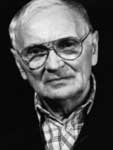Theatre Design
Good Company
Approaching each work of theatre or performance afresh with that dark empty stage and nothing more than a script or score is indeed a daunting task for young and old designers and scenographers alike. There is some comfort to be found reading this quote from Josef Svoboda however – if the scenographer regarded as the father of modern theatre design and scenography felt the same fears as the rest of us then we are keeping very good company indeed!
[ad#10Article]
Josef Svoboda was born on May the 10th 1920 in Caslav, Czechoslovakia (Czech Republic after 1993). He was first attracted to the world of theatre whilst studying at the Central School of Housing in Prague, however it was not until the end of World War II that he began to study scenography at the Prague Conservatory and architecture at the Academy of Applied Arts.
Polyekran
When Svoboda died on April the 8th 2002, it was estimated that he had designed and/or directed over 700 theatrical and operatic performances. It seems an impossible and somewhat pointless task trying to identify which of his productions one should reference to a reader, as the influences of all of Svoboda’s work are tangible and pertinent to contemporary theatre. However his multimedia installations “Laterna Magika” and “Polyekran” with director Alfred Radok at the 1958 World Fair in Brussels (also shown at the 1967 expo in Montreal, Canada) would be two good starting points. The shows featured a montage of performers and projections thrown onto live action and scenic elements, but this wasn’t projection for projection’s sake – Svoboda used the images and light of the projection to sculpt the scenic elements. In Polyekran a wall of cubes shifted position, moving forwards and backwards, inside each cube a projector threw images onto the surface of the cube facing the audience. Light, photographic image, object and object manipulation combined to create a living, moving work of performance art.
In his lifetime Svoboda worked with companies and directors the world over – his designs for Opera and Theatre ranged from the epic to the sublime. His reputation as the most influential scenographer of the 20th century is well deserved and supported by his work for many academic institutions, and his role in educating and training younger scenographers the world over.
To read more about Josef Svoboda visit the Laterna Magika Theatre website.

Comments are closed.